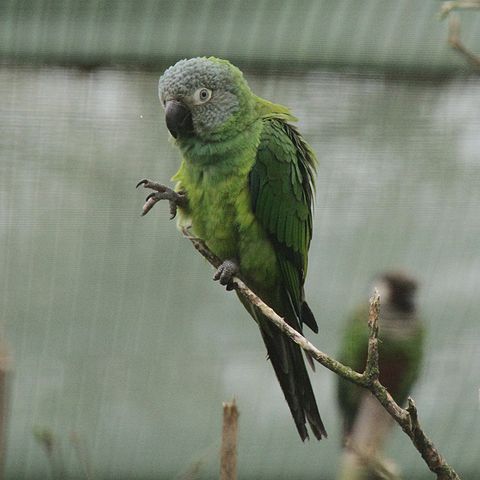
Dusky-headed Parakeet
[order] PSITTACIFORMES | [family] Psittacidae | [latin] Aratinga weddellii | [authority] Deville, 1851 | [UK] Dusky-headed Parakeet | [FR] Conure de Weddell | [DE] Weddellsittich | [ES] Aratinga Cabecifusca | [NL] Weddells Aratinga | [copyright picture] David Long
Monotypic species
Genus
The parrot genus Aratinga comprises 24 species. Aratinga is a genus of American parakeets. They belong to the long-tailed group. Most are predominantly green, although a few are predominantly yellow or orange. They are social and commonly seen in groups in the wild. In Brazil the popular name of several species usually is Jandaia, sometimes written as Jandaya in the scientific form.
The genus Aratinga includes species with habitat from South America to Mexico. Birds in the Aratinga genus have a “swift, direct flight” that differs from other similar birds according to “Parrots of the World.” Other characteristics include the males and females looking alike, a fully feathered face and a rather long tail that starts wide at the base and becomes slender at the tip.
Generally green; greenish-yellow on abdomen; head greyish-brown, each feather edged dull blue; upper breast olive-green; first primaries black with blue edge; remainder green with bluish edging on ends of outer webs; tail upperside blue with green base, underside blackish; skin to very wide periophthalmic ring white; bare cere reddish-grey; bill black; iris pale yellow; feet grey.
Listen to the sound of Dusky-headed Parakeet
[audio:http://www.planetofbirds.com/MASTER/PSITTACIFORMES/Psittacidae/sounds/Dusky-headed Parakeet.mp3]
Copyright remark: Most sounds derived from xeno-canto
recorded by Bradley Davis
| wingspan min.: |
0 |
cm |
wingspan max.: |
0 |
cm |
| size min.: |
28 |
cm |
size max.: |
30 |
cm |
| incubation min.: |
23 |
days |
incubation max.: |
25 |
days |
| fledging min.: |
52 |
days |
fledging max.: |
57 |
days |
| broods: |
1 |
|
eggs min.: |
3 |
|
| |
|
|
eggs max.: |
4 |
|
South America : Colombia to Bolivia. Amazon tributaries in southeast Colombia, eastern Ecuador, eastern Peru, northwest and northeast Brazil.
Rain forest along rivers, marshy areas, forest remnants in humid savanna; secondary vegetation and cleared areas with isolated woodland to 750 m (2,300 ft); occasionally on edges of rain forests and sometimes in coffee plantations.
The pair raises their offspring together, nesting in woodpecker holes in trees or arboreal termite nests. They lay three to four eggs which are incubated for 24 days. Once hatched the young will stay in the nest for about 55 days
in pairs or groups of 3 to 8 birds outside breeding season, occasionally flocks of 75 to 100 birds when sufficient food available; nomadic; prefers river bank areas; roosting trees also here; seldom flies over thick forest; inconspicuous; very quiet when feeding; mostly makes sound only during flight; call similar to White-eyed Conure (Aratinga leucophthalmus), but more refined and sharper. Diet consists of seeds, fruits, flowers and berries; seeks out decaying trees probably for insects and their larvae; regularly visits areas in forest and on river banks where soil containing minerals to be found.
Video Dusky-headed Parakeet
httpv://www.youtube.com/watch?v=MzGclo4_QmY
copyright: Josep del Hoyo
This species has an extremely large range, and hence does not approach the thresholds for Vulnerable under the range size criterion (Extent of Occurrence <20,000 km2 combined with a declining or fluctuating range size, habitat extent/quality, or population size and a small number of locations or severe fragmentation). The population trend appears to be increasing, and hence the species does not approach the thresholds for Vulnerable under the population trend criterion (>30% decline over ten years or three generations). The population size has not been quantified, but it is not believed to approach the thresholds for Vulnerable under the population size criterion (<10,000 mature individuals with a continuing decline estimated to be >10% in ten years or three generations, or with a specified population structure). For these reasons the species is evaluated as Least Concern.
It sometimes forms large flocks, which may perform local movements in response to changes in food supplies.



